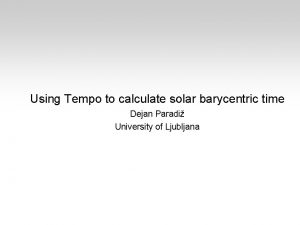Shanghai TMP 2004 Top Management Program Shanghai Prof











- Slides: 11

Shanghai TMP 2004 Top Management Program Shanghai Prof. F. . M. Macaranas May 2004

I. Introduction to Chaos Theory

Introduction to Chaos Theory A. Clarification / definition of terms 1. Chaos theory n Definition: science that determines order in the randomness and unpredictability that exist in the natural and social systems Ex: coastlines, mountains, clouds, galaxy clusters, leaves, heart rhythms, etc.

Introduction A. Clarification / definition of terms 1. Chaos theory applications Self-organization in public administration: citizens can co -create goals, plans, and outcome that can be sustained by them and communities Dynamic evolution of industries and complex interactions among industry actors Human interaction and leadership styles: business organizations as complex adaptive systems Firms respond to changes in the environs more effectively if authentic relationships are valued at all levels of the companies Monsanto experiment: overloading 22, 000 people to find new and creative ways of adapting to new environ

Introduction A. Clarification / definition of terms 1. Chaos theory applications Long-term strategies that are incremental and adaptive rather than prescriptive and rigid Furnaces that burn hotter, metals that can be more stressed, cars that burn fuel without stalling out Non-linear thinking in crisis management: real-time information provided by CNN during the Gulf War change political and military decisions unexpectedly

Introduction A. Clarification / definition of terms 1. Chaos theory underlying principles n n n n n Non-linearity Determinism Sensitivity to initial conditions Sustained irregularity in the behavior of the system Unpredictable long-term behavior Self-organization Positive feedback loops Qualitative character of systems rather than numerical predictions of future states Unstable Aperiodic – no periodic repetition of values

Characteristics of Systems System Order Chaos Randomness Paradigmatic Example Clocks, Planets Clouds, Weather Snow on TV Screen Predictability Very High Finite, Short Term None -> Simple Laws Effect of Small Errors Very Small Explosive Nothing BUT Errors Spectrum Pure Yes! Noisy, Broad Dimension Finite Low Infinite Control Easy Tricky, Very Effective Poor Attractor Point, Cycle, Torus Strange, Fractal No!

Introduction A. Clarification / definition of terms 3. Chaos theory-based SWOT Identify the Strengths of an entity Classify whether these are characterized by order chaos randomness Identify W, O, and T Combine internal and external elements Think of a strategy based on the combination

Chaos Theory Example Chaotic systems, in this case a fractal, can appear to be smooth and ordered.

Chaos Theory Example: The Sierpinski’s Triangle fourth recursion first recursion third recursion second recursion

Applications to New Concept of National Security A. Clarification / definition of terms 3. SWOT analysis n Definition: a strategic model in management that combines internal strengths and weaknesses of an entity, and external opportunities and threats facing the same entity Opportunities Threats Strengths S-O S-T Weaknesses WO W-T Fractals are recursively defined and infinitely detailed
 Cvvh lijn
Cvvh lijn Multimedia presentation rubric
Multimedia presentation rubric Tmp smx dosis pediatrica
Tmp smx dosis pediatrica Hilton tmp
Hilton tmp Tmp tempoe
Tmp tempoe Tmp safety
Tmp safety Top management and middle management
Top management and middle management Top management middle management first line management
Top management middle management first line management Middle level management
Middle level management Enterprise information management gartner magic quadrant
Enterprise information management gartner magic quadrant Openstack summit shanghai
Openstack summit shanghai Tour petronas et tour eiffel
Tour petronas et tour eiffel




















